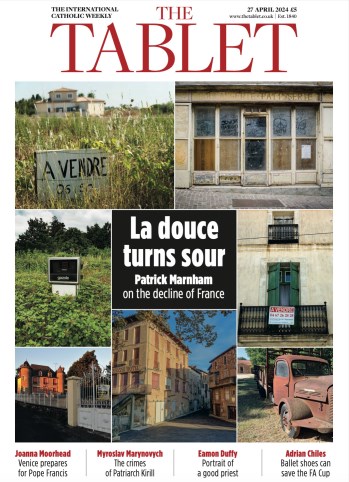What do you write after you have written a history of the world? Not everyone would think of moving on to a history of Germany. But Neil MacGregor’s sequel to A History of the World in 100 Objects – like its predecessor, the richly illustrated companion to a British Museum exhibition and to an addictive series of radio broadcasts – is not just a history. Its urbane and media-savvy presentation conceals some surprisingly radical, and topical, thoughts about the past and present not just of Germany but of all Europe, not excluding the United Kingdom.
As before, MacGregor creates an agreeably informal atmosphere by introducing an object or a theme on which experts comment through extracts not from their scholarly works but from specially recorded interviews. MacGregor himself writes with a knowledge of Germany, its language, and its daily life, that can only come from deep personal acquaintance, even, one might say, from love. The objects, as those who know A History of the World will expect, are pictured beautifully, interpreted with great learning and skill, and splendidly and ingeniously varied – more so than in the previous book since MacGregor is not confined to the holdings of the British Museum and can refer not only to little things like curry-flavoured sausages and amber beer-tankards and bank-notes for a trillion marks, but to monuments as large as the Brandenburg Gate or the Regensburg Valhalla. The simple formal cohesion of the History of the World may be lost, but the 30 chapters still relate directly to items in the exhibition, some of which are so magnificent and moving as to make a visit before it closes on 25 January irresistible.
Dürer figures, of course, as “an artist for all Germans” (and the inventor of the logo), and Caspar David Friedrich too, though rather under-represented with one of his less eerie landscapes, but the stars of the show are surely two sculptors, with works which the British public is never likely to see again: Tilman Riemenschneider’s Four Evangelists, glowing in old-gold limewood, and Ernst Barlach’s Hovering Angel (lent out only twice before from Güstrow Cathedral, where it hangs in mid-air over the font).
Riemenschneider’s graceful and spirit-full and profoundly individualised faces are taken directly from his contemporaries in the late-medieval German cities at the time of their greatest flowering. They speak not, as one of MacGregor’s interlocutors has it, of the Protestantism to which Riemenschneider never subscribed, but of the Catholic personal and devotional culture of the fifteenth century, to which the official Church did not listen until forced to do so by the Reformation.
Barlach’s experience of the First World War made him a pacifist – Germany’s equivalent of the English war-poets, as MacGregor shrewdly remarks. Though his bronze seems executed with the rough energy of a rustic wood-carver, its power is contained and transfigured by the meditative and suffering face of Barlach’s friend and collaborator, Käthe Kollwitz – one of Germany’s greatest artists, in MacGregor’s view, whose secular pietà is now the solitary occupant of the empty space of the Neue Wache in Berlin, as a memorial “to the victims of war and tyranny”.
The key to this seemingly innocent picture book’s unique character lies in its subtitle: “memories of a nation”. It is not just another beginner’s guide to German Studies, though it would certainly make a great present for anyone starting a course, or just interested, in German language, history or culture. It has its weaknesses – it does not say enough about philosophy or music and it says almost nothing about universities, one of the few forces for continuity in German history. Its account of Goethe, the only literary figure treated at any length, is rather conventional. But it has the great and unusual strength that it is about memories, about the objects that carry them, whether deliberately or accidentally, and about their role in making the Germany we know today. But it is also about past Germanies, real or imagined, the forebears of a country that is now not so much a nation as a memory of one. And in that, MacGregor’s subversive message runs, Germany is perhaps more like the rest of us than we realise.
Two themes run through this book that will cause British readers to revise their perspective on their own national story. First, that, although Germany figures in our minds as the archetypal aggressor, it has actually more often been the victim – and usually of France, whether embodied in Louis XIV, or Napoleon, or the iniquitous settlement at Versailles. And second, as is also shown by the excellent series of maps, during the almost 1,000 years for which it was a subset of autonomous, but not sovereign, components of the Holy Roman Empire, Germany, as we now call it, managed quite happily and productively without being a nation at all. MacGregor clearly thinks that in a Germany which as a result has, he says, “so few problems with the idea of a confederal supranational EU” there may be a lesson for a UK that “with its very different history, has so many”.
During the Scottish referendum Britain briefly woke up to the unsettling thought not only that it might not be a nation in the future, but also that it might not have been one for much of the past either. It would be nice to read a parallel book to the present one devoted to Britain, especially if it could be produced by the German Historical Museum in Berlin.
30 December 2014, The Tablet
Germany: memories of a nation
Radical view of a fragmented state
La douce turns sour
 Loading ...
Loading ...
Get Instant Access
Subscribe to The Tablet for just £7.99
Subscribe today to take advantage of our introductory offers and enjoy 30 days' access for just £7.99



What do you think?
You can post as a subscriber user...
User Comments (0)